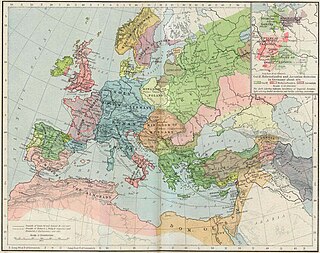
A defensive wall is a fortification usually used to protect a city, town or other settlement from potential aggressors. In ancient to modern times, they were used to enclose settlements. Generally, these are referred to as city walls or town walls, although there were also walls, such as the Great Wall of China, Walls of Benin, Hadrian's Wall, Anastasian Wall, the Cyclopean Wall Rajgir and the metaphorical Atlantic Wall, which extended far beyond the borders of a city and were used to enclose regions or mark territorial boundaries. In mountainous terrain, defensive walls such as letzis were used in combination with castles to seal valleys from potential attack. Beyond their defensive utility, many walls also had important symbolic functions – representing the status and independence of the communities they embraced.

A barbican is a fortified outpost or gateway, such as an outer defence to a city or castle, or any tower situated over a gate or bridge which was used for defensive purposes.

A ravelin is a triangular fortification or detached outwork, located in front of the innerworks of a fortress. Originally called a demi-lune, after the lunette, the ravelin is placed outside a castle and opposite a fortification curtain.

Indre By, also known as Copenhagen Center or K or Downtown Copenhagen, is an administrative district (by) in central Copenhagen, the capital of Denmark. It covers an area of 4.65 square kilometres (1.80 sq mi), has a population of 26,223, and a population density of 5,638 per km².

Bratislava fortifications usually refers to the medieval city fortifications of Bratislava, the capital of Slovakia, of which one gate and two sections of walls remain today. The Bratislava Castle was also heavily fortified. Other fortification systems were built in the following centuries, including a World War I artillery fortification system and World War I shelters, system of bunkers and fortifications built by the First Czechoslovak Republic between the World Wars, World War II aircraft raid shelters, fortifications built by the Nazi Germany in the city during World War II and finally Cold War-era city defenses including a system of 8,602 air raid and nuclear shelters capable of holding over 760,000 citizens, far more than the number of inhabitants. The pinnacle of the communist era city defense was a military rocket base located on the Devínska Kobyla hill, the highest point in the city.
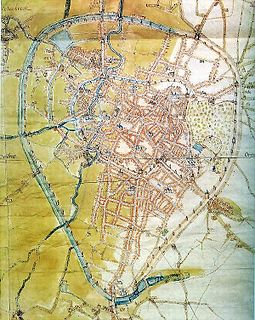
There were two stages of fortifications of Brussels, the first walls, built in the early 13th century, and the second walls, built in the late 14th century and later upgraded. Today, only a few sections of either remain.

A Tenaille is an advanced defensive-work, in front of the main defences of a fortress, which takes its name from resemblance, real or imaginary, to the lip of a pair of pincers. It is "from French, literally: tongs, from Late Latin tenācula, pl of tenaculum".
Porta Tenaglia was one of the gates of the old Spanish walls of Milan, Italy. It owes its name to the so-called "Tenaglia" (pincer), a fortified walls system that embraced the north-west side of the Sforza Castle. The gate was demolished in the 16th century. Today, the phrase "Porta Tenaglia" is still in use to refer to the district ("quartiere") where the gate used to be, including the Piazzale Biancamano square and part of the Simplon Park. The Porta Tenaglia neighbourhood is part of the Zone 1 district.

Claustra Alpium Iuliarum was a defense system within the Roman Empire between Italia and Pannonia that protected Italy from possible invasions from the East. It secured the Postojna Gate, the land link between the eastern and western part of the empire, and thus the Claustra represented an inner border defense of the empire. Unlike a linear rampart, the Claustra consisted of a series of interconnected fortifications with its center at Castra ad Fluvium Frigidum ; other important fortresses were Ad Pirum on today's Hrušica Plateau and Tarsatica, now a part of the city of Rijeka. They had been governed from the town of Aquileia.

The Venetian Walls are a series of defensive walls which surround the capital city of Nicosia in Cyprus. The first city walls were built in the Middle Ages, but they were completely rebuilt in the mid-16th century by the Republic of Venice. The walls are still largely intact, and are among the best preserved Renaissance fortifications in the Eastern Mediterranean. They are a major tourist attraction.
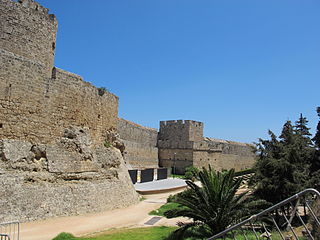
The fortifications of the town of Rhodes are shaped like a defensive crescent around the medieval town and consist mostly in a modern fortification composed of a huge wall made of an embankment encased in stone, equipped with scarp, bastions, moat, counterscarp and glacis. The portion of fortifications facing the harbour is instead composed of a crenellated wall. On the moles towers and defensive forts are found.
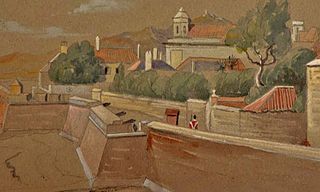
The Line Wall Curtain is a defensive curtain wall that forms part of the fortifications of the British Overseas Territory of Gibraltar.

Flat Bastion is a bastion which projects southward from the Charles V Wall in the British Overseas Territory of Gibraltar. Once known as the St. Jago's Bastion or the Baluarte de Santiago in Spanish, the fortification was built by the Spanish in the mid 16th century and formed part of the southern defences of the city of Gibraltar, together with Charles V Wall, Southport Gates, Southport Ditch, and South Bastion. In 1859, six guns, four 12-pounders and two 12-pound carronades, were installed on the bastion, and four years later, five 32-pounders were mounted on the fortification.

The Southport Gates are three city gates in the British Overseas Territory of Gibraltar. They are located in the Charles V Wall, one of the 16th century fortifications of Gibraltar. The gates are clustered together, with the South Bastion to the west, and the Trafalgar Cemetery to the east. The first and second Southport Gates were constructed at present day Trafalgar Road in 1552 and 1883, respectively. The third gate, Referendum Gate, is the widest of the three and was constructed in 1967 at Main Street, immediately west of the first two gates. The Southport Gates are listed with the Gibraltar Heritage Trust.

A Zwinger is an open area between two defensive walls that is used for defensive purposes. Zwingers were built in the Middle Ages and Early Modern Period to improve the defence of castles and town walls. The term is German and usually left untranslated. However, it is sometimes rendered as "outer courtyard" presumably referring to the subsequent role of a Zwinger as a castle's defences became redundant and it was converted into a palace or schloss, however, this belies its original purpose as a form of killing ground for the defence. The word is linked with zwingen, "to force", perhaps because the Zwinger forced an enemy to negotiate it before assaulting the main defensive line. Essenwein states that the "main purpose of this feature was so that the besieging force could not reach the actual castle wall very easily with battering rams or belfries, but had to stop at the lower, outer wall; also that two ranks of archers, behind and above one another, could fire upon the approaching enemy"
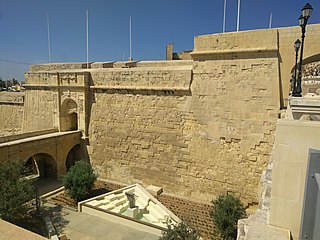
The fortifications of Birgu are a series of defensive walls and other fortifications which surround the city of Birgu, Malta. The first fortification to be built was Fort Saint Angelo in the Middle Ages, and the majority of the fortifications were built between the 16th and 18th centuries by the Order of Saint John. Most of the fortifications remain largely intact today.
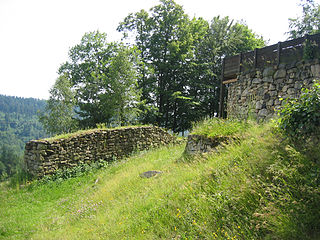
The Heunischenburg is a stone fortification of the late Urnfield period near the Upper Franconian town of Kronach in Germany. Its heyday was in the 9th century BC, making it the oldest stone fortification north of the Alps that is known and archaeologically investigated.

A chamber gate is a type of gateway system on medieval town fortifications and castles that comprises at least two successive gateways linked by an easily defended passageway between two walls. Chamber gates can be built in the space between two enceintes or built into an enceinte as an independent gateway. Because relatively few fortifications are surrounded by a complete second defensive wall, chamber gates are frequently found in short zwinger sections.

The defense lines of the Sasanians were part of their military strategy and tactic. They were networks of fortifications, walls, and/or ditches built opposite the territory of the enemies. These defense lines are known from tradition and archaeological evidence.







